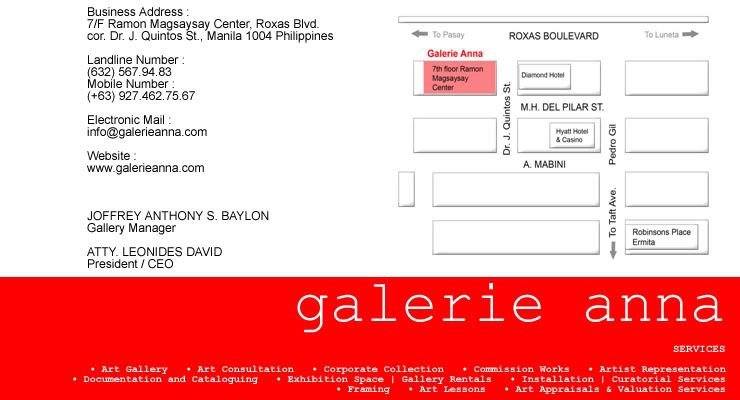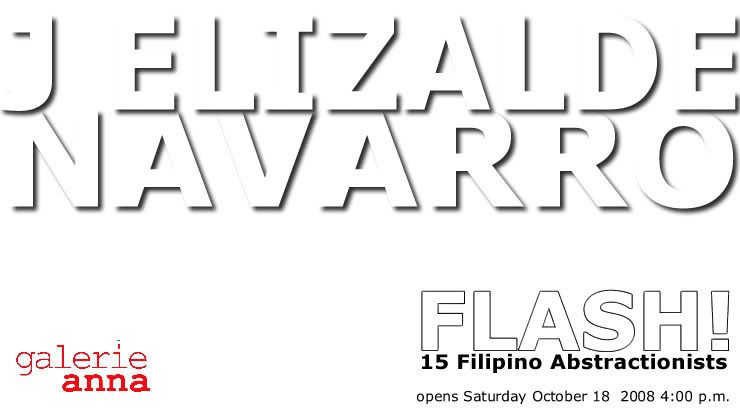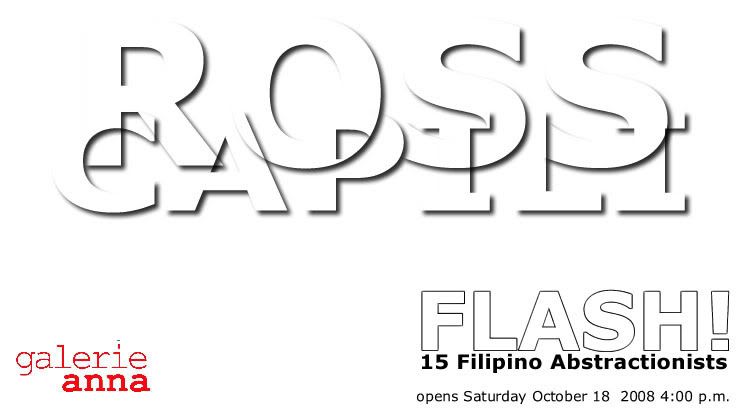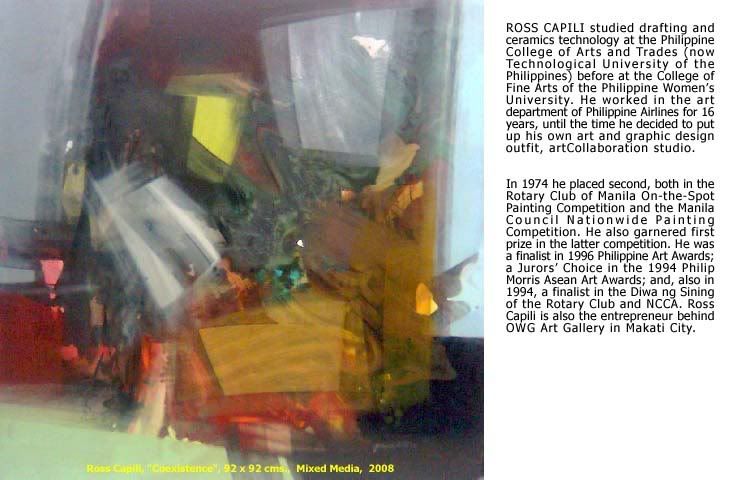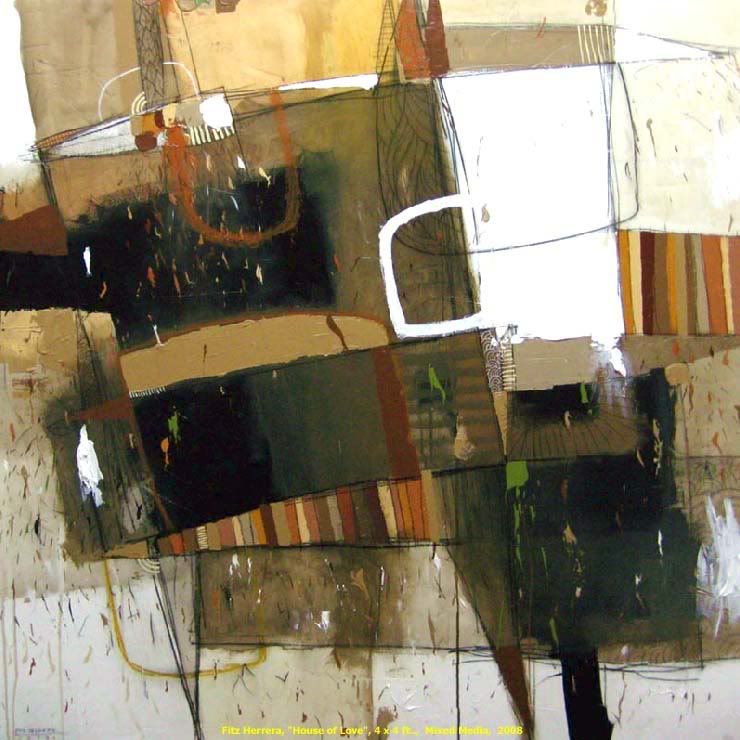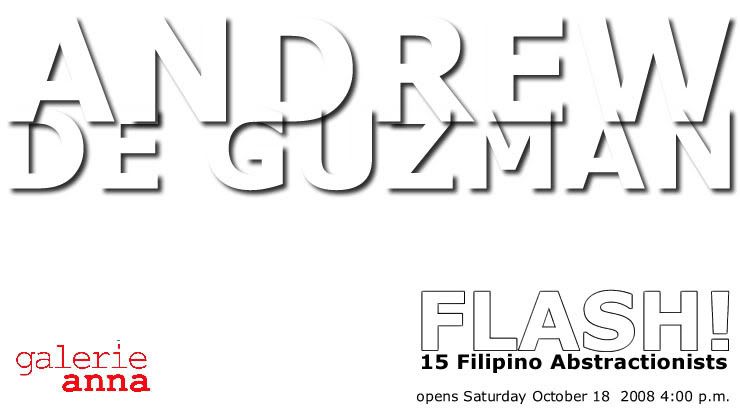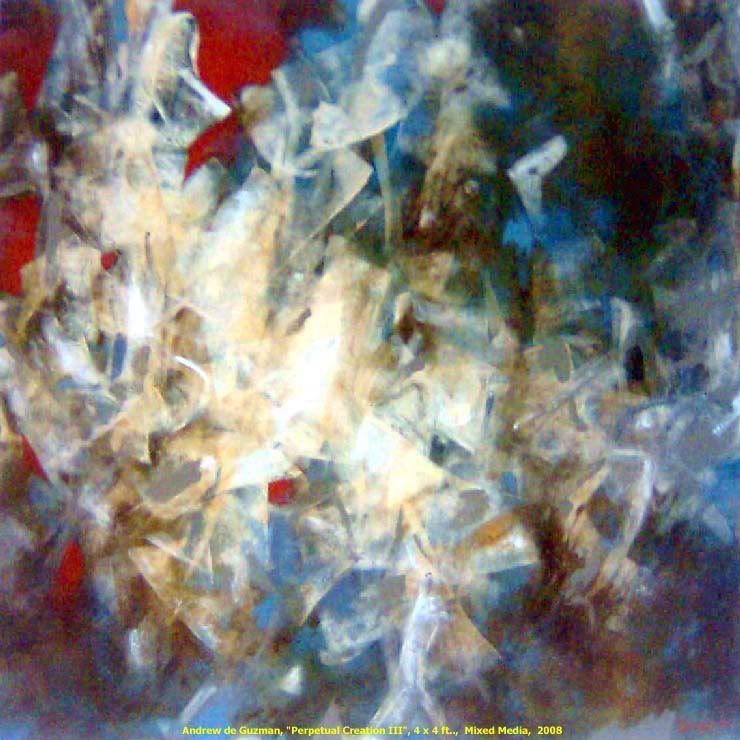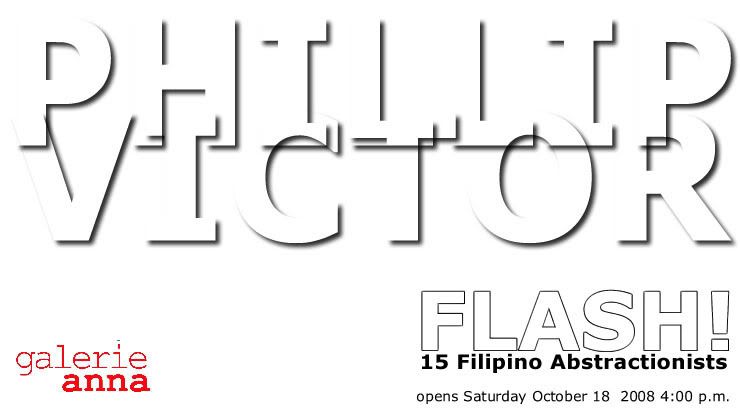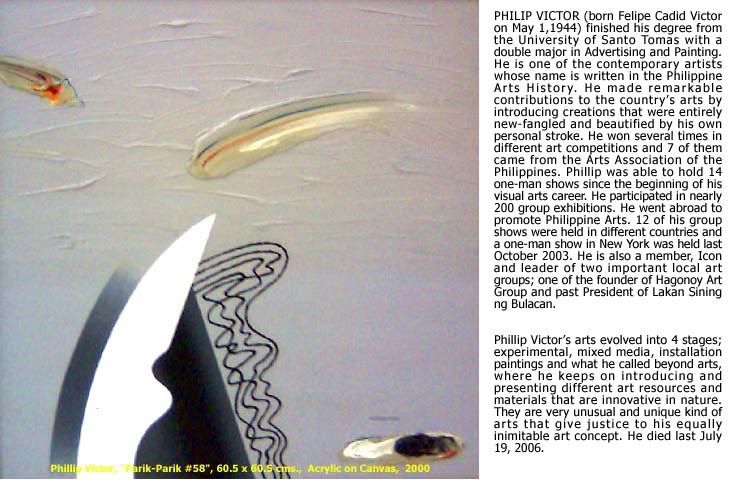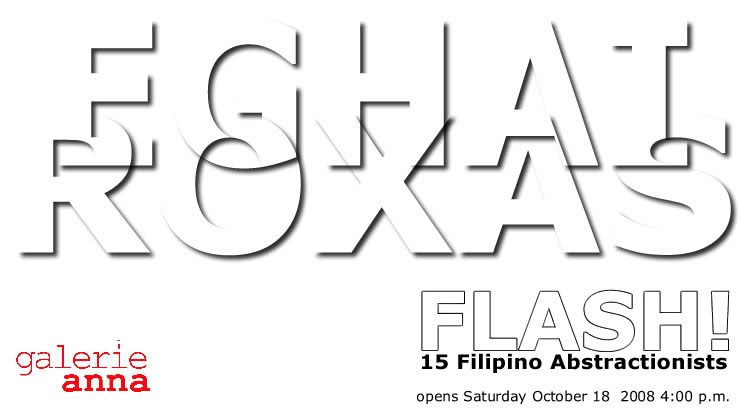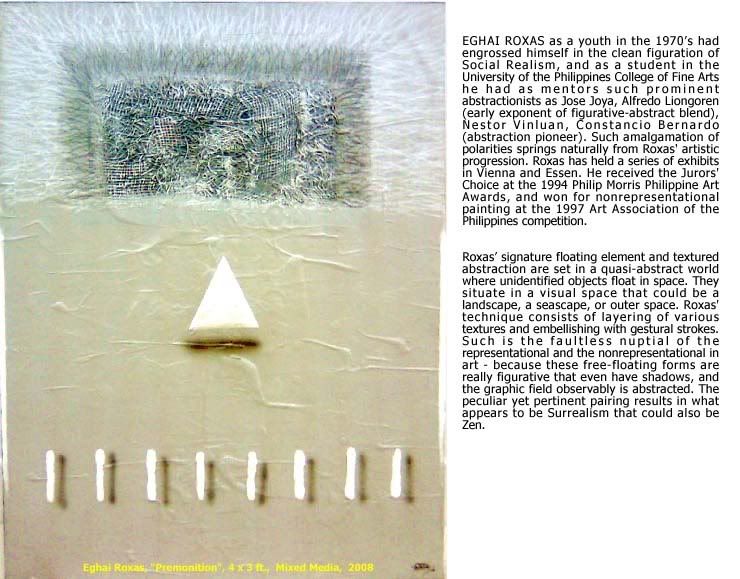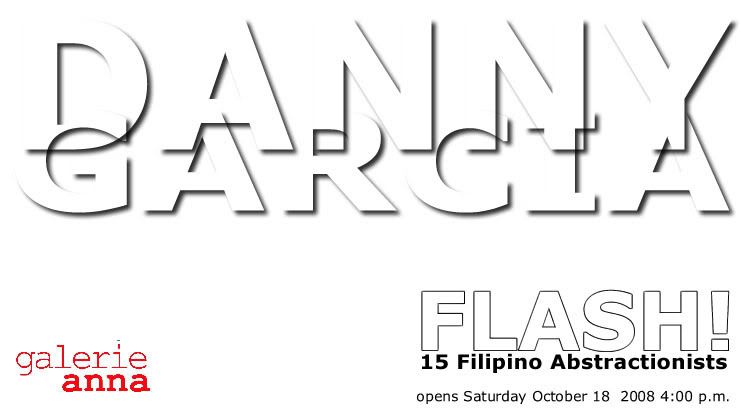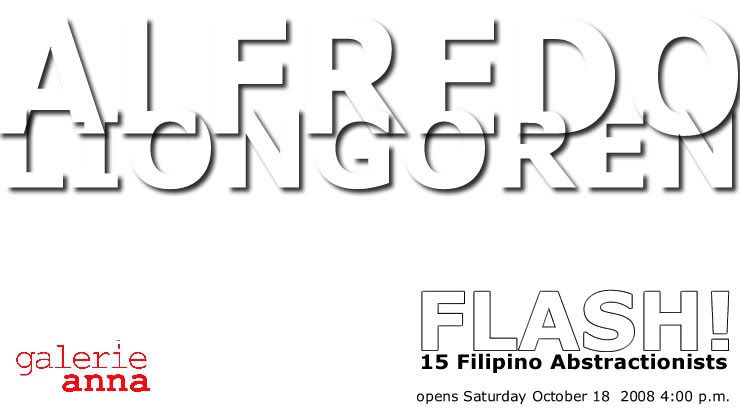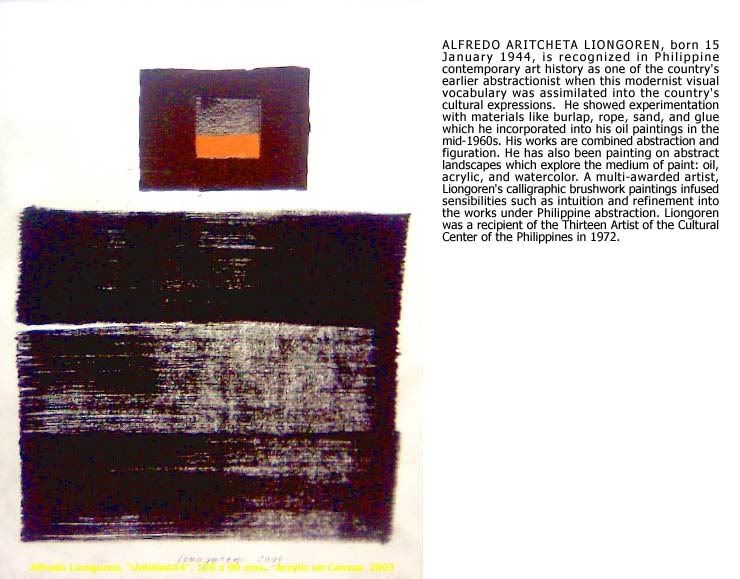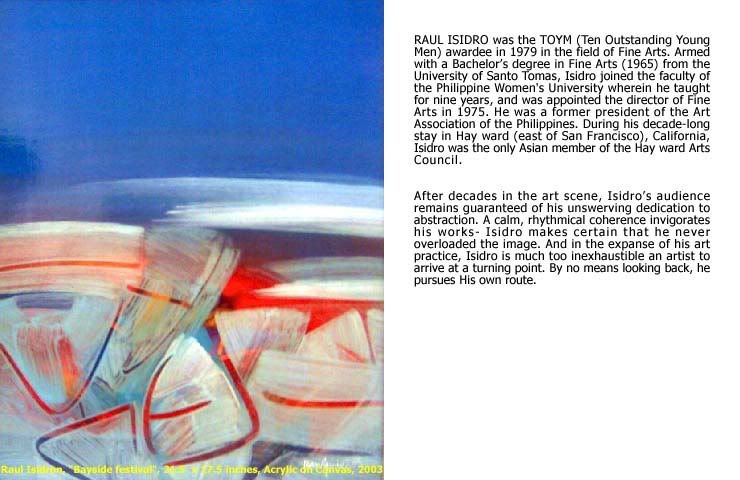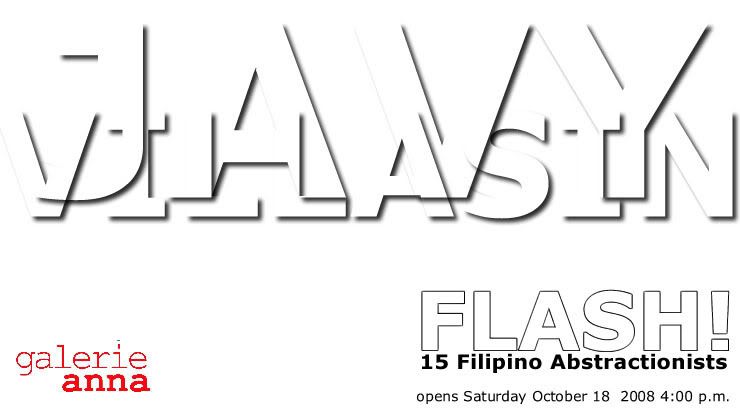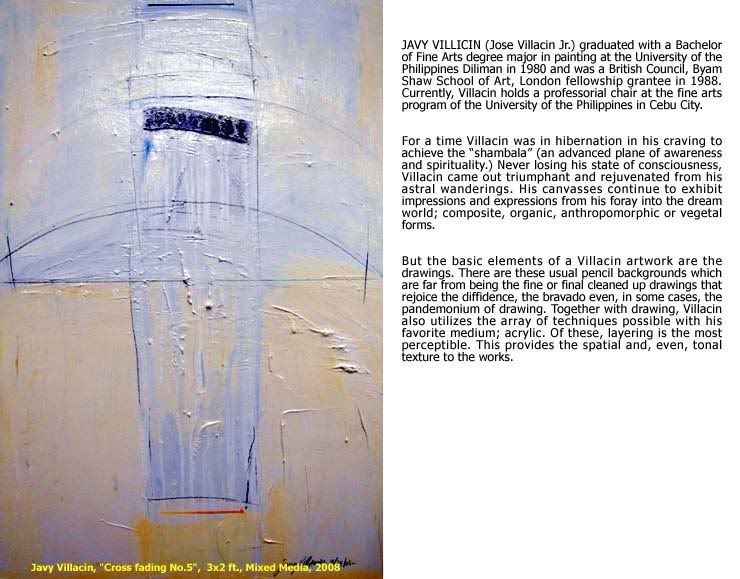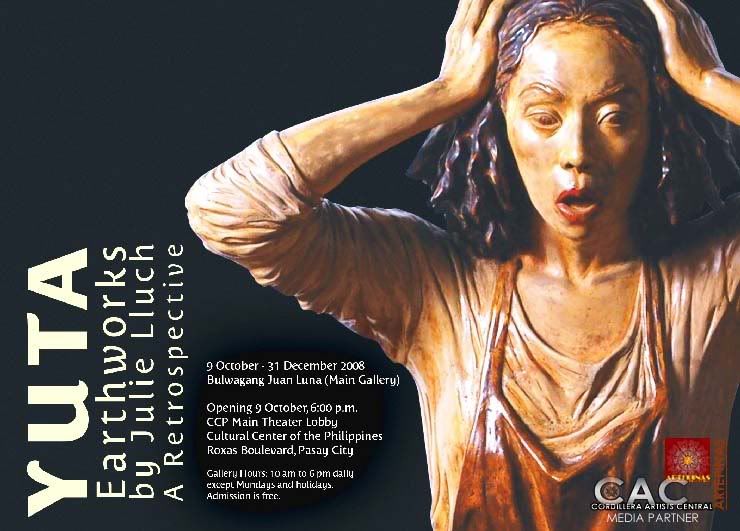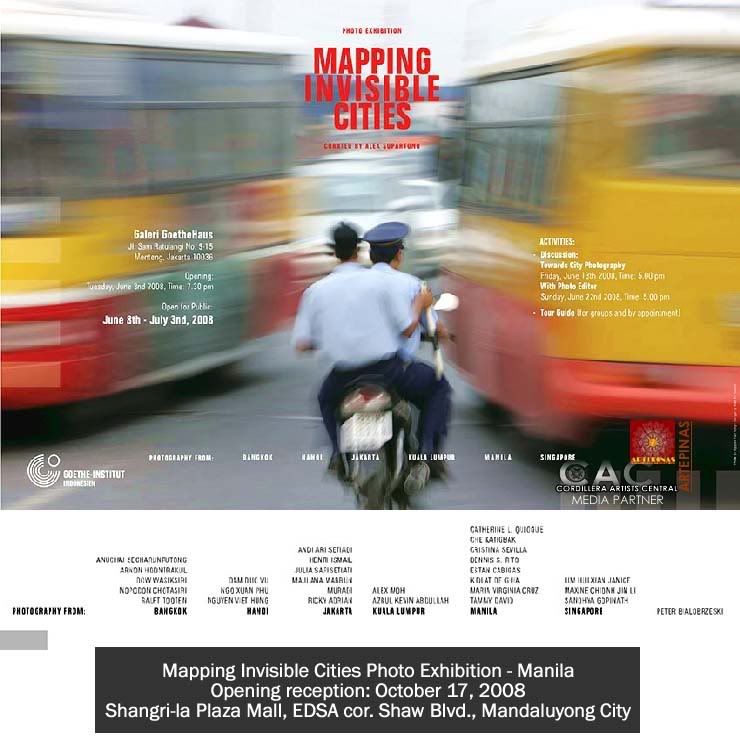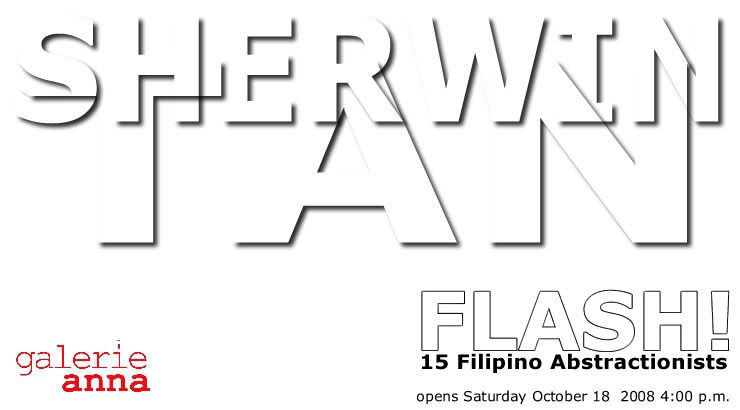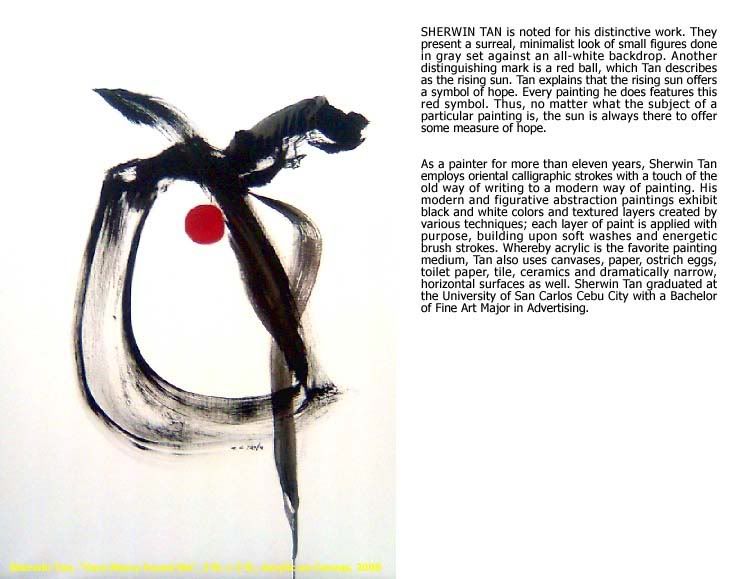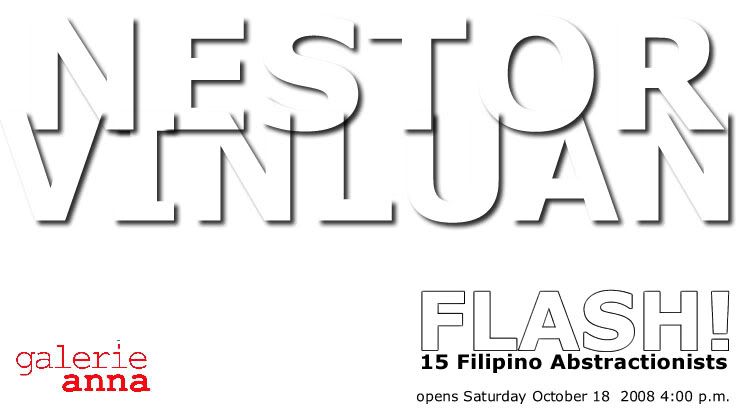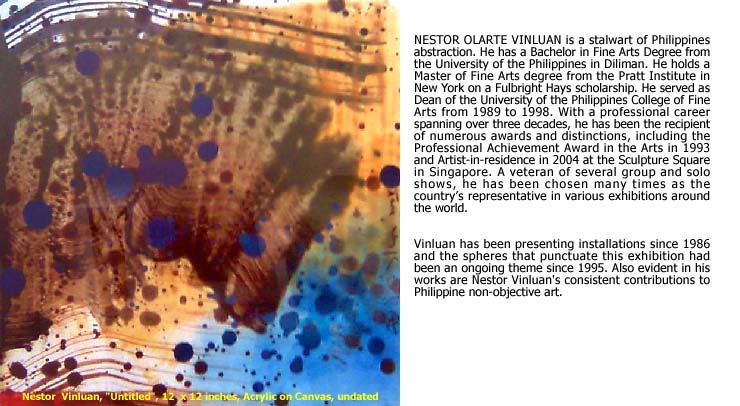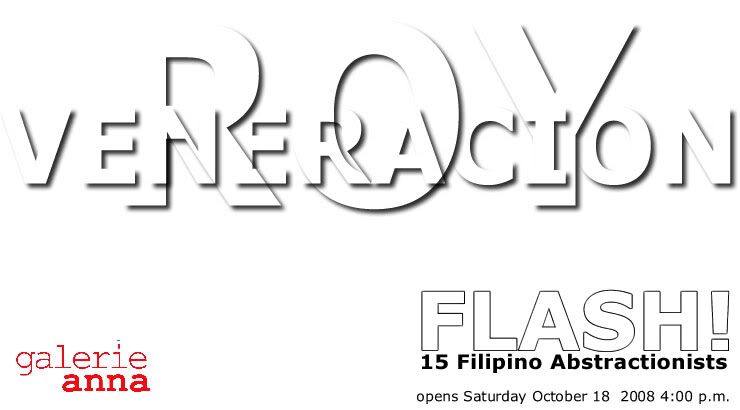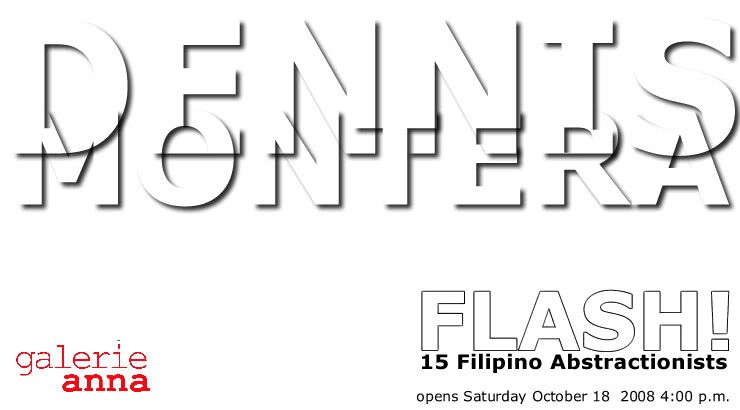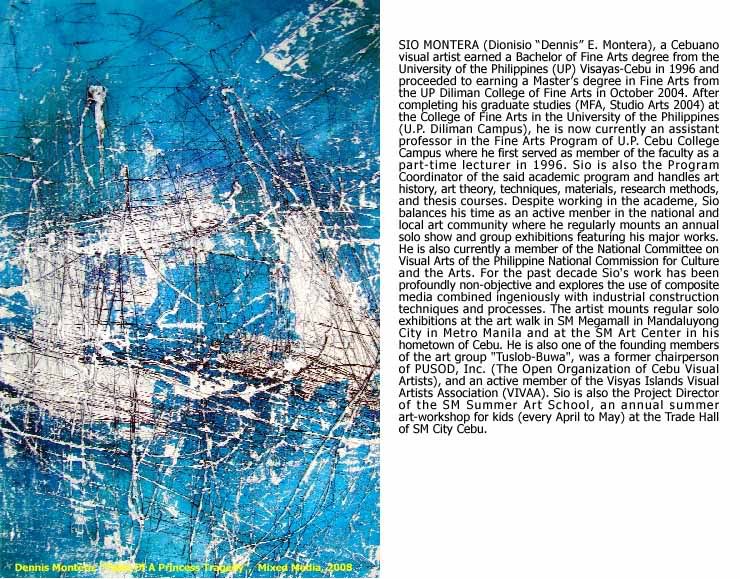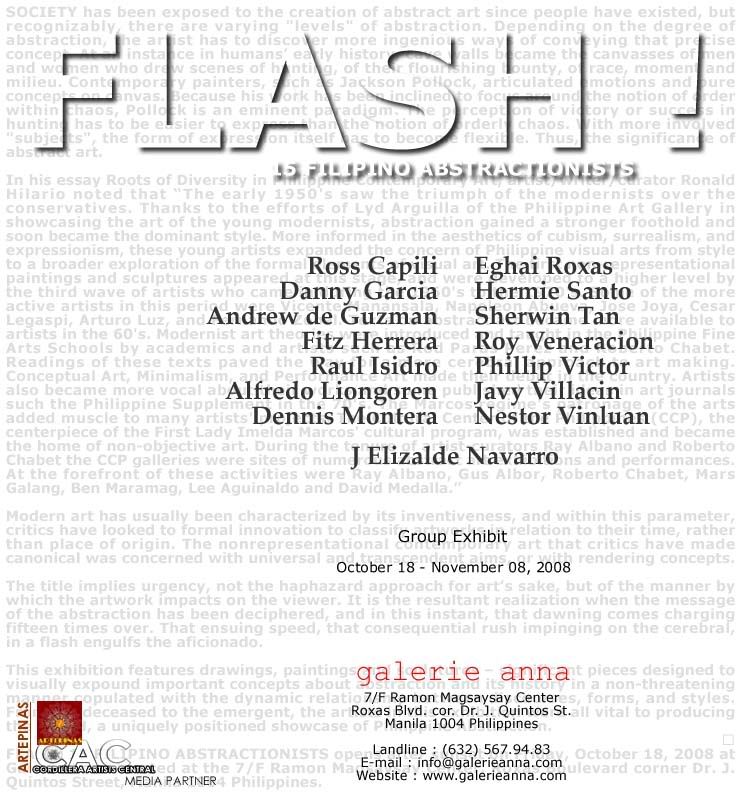
FAITH IN A FLASH
Philippine Abstraction in the Po-Po-Mo Globe
Reuben Ramas Cañete
“…the built environment professions are witnessing the gradual dawn of a post-Postmodernism that seeks to temper reason with faith”
Tom Turner, City as Landscape: A Post Post-modern View of Design and Planning (Taylor & Francis: London 1995), p. 9.
Reports of the death of Abstraction, to paraphrase a quote by Mark Twain, have been greatly exaggerated. The dominance of Postmodernism in the late 20th Century that has been characterized (often by furious orthodox purists) as a chaotic and irreverent jumble of sources, styles, and narratives had often implied the demise of this most distinctive—and totalitarian—of Modern art movements. The charge is centered on the monolithic construct that Abstraction has been wrapped in ever since Clement Greenberg infamously associated figurative art with kitsch, and elevated the avant-garde as the historical fulfillment of modernity’s zeitgeist—an avant-garde located primarily and purely in the non-objective aesthetics of Kandinsky, Hoffmann, Gorky, and Pollock.
By contrast, Postmodern art, in its implicit critique of Modernism’s patriarchal intolerance, advocated the return of subject matter, representation, and narrative in art, and the fusion (some would say mix-match) of several styles and genres together to foreground an aesthetics of difference and hybridity. If one can define a style by its opposition, Postmodernism’s appeal lies precisely in “its (inclusion of) the ironic play with styles, citations and narrative levels, a metaphysical skepticism towards the ‘grand narratives’ of Western culture, a preference for the virtual at the expense of the real, and a ‘waning of affect’ on the part of the subject, who is caught up in the free interplay of virtual, endlessly reproducible signs inducing a state of consciousness similar to schizophrenia.”
It is thus no wonder that, in the past fifteen years, a growing chorus of complainants about Postmodernism’s own increasing faddish dominance has arisen, and attempted to articulate this opposition to Modernism’s nemesis through the concept of Post-Postmodernism, or “Po-Po-Mo.” “Po-Po-Mo” is supposedly a theory that recuperates from Postmodernism’s epistemological violence against Modernism by emphasizing the (Modernist) values of “faith, trust, dialogue, performance or sincerity (that)…can work to transcend postmodern irony.” Articulated by such critics as architectural scholar Tom Turner, the Russian-American literary critic Mikhail Epstein, American cultural theorist Eric Gans (who calls it “post-millenialism”), German-American Slavist Raoul Eshelman (who calls it “performatism”), radio talk-show host Jesse Thorn (who calls it “New Sincerity”), and British cultural historian Alan Kirby (who calls it “pseudo-modernism”), the various strains of critique against Postmodernism through “Po-Po-Mo” resolve their common stance through the following key concepts: the return of order and regularity; the demise of irony and free play, and the reiteration of "trans-subjectivity," "trans-idealism," "trans-utopianism," "trans-originality," "trans-lyricism," "trans-sentimentality"; a rejection of “victimary discourse”; a unified, aesthetically mediated experience of transcendence through the experience of beauty, love, belief and transcendence under particular, artificial conditions; the promotion of “good feelings”; and a pessimistic view of instantaneity and social cohesion brought about by technological interventions in social discourse.
Doubtless, such assertions are based on (an admittedly Occidental-centric) viewpoint that is at best testy, and at worse in denial of the conditions of the contemporary (Po-Po)Modern world left in inequilibrium after the unitary triumphalism of western global capitalism that still leaves pockets of uneven material relations across the supposedly harmonized planet. Po-Po-Mo’s attraction lies in its recall of eternal verities and universal validations that came under ceaseless attack from the Po-Mos, an attack that uncovered Modernism’s uncritical and untheorized power-positionality in discourse and agency, but which also left Po-Mo open to counter-attack from neo-conservatives who feel that Po-Mo’s concepts of hybridity and heterogeneity allows them the license to “articulate their voices differently as marginal discourse vis-à-vis the centrality of irony and grand narration of Postmodern practice.”
In this atmosphere where Modernism’s values are once again resurgent in the face of neo-con’s collective counter-thrust, it is an apt development that the term “faith” has once more entered the epistemic vocabulary, and the central arena of debate between the parrying parties. This turn is important, not only to Modernism, but also to Postmodernism (and thus to Po-Po-Mo) because it shifts the focus of the debate from material issues (where things easily bog down again thanks to the ambivalent position by both sides to Marxian political economy) to metaphysics, where much territory has yet to be illuminated and re-charted. Po-Po-Mos, in their collective eagerness (or indifference, for that matter) to deconstruct Postmodernism’s debilitating critiques of Modernist preordination, inadvertently reopen the one linkage that actually bridges the artificial divide between resurgent modernity and threatened postmodernity: the issue of belief.
Pierre Bourdieu, in his essay “The Production of Belief”, articulates the formation of artistic practice through a “(practice of) negotiation…(that) can only work by pretending not to be doing what they are doing.” This is based on what Bourdieu sees as the “economism (that) lies precisely in the fact that they function…in practice…only by virtue of a constant, collective repression of narrowly ‘economic’ interest and of the real nature of the practices revealed by ‘economic’ analysis.” What this means is that terms like “art” (or for that matter “religion”, “politics”, or even “life”) are made, not by some mystical and changeless process, but by an active process of continuing historical relations between “stakeholders”, including those who are left out of the process of naming, and thus as liable to “(re)define” the term not by their presence but by their “absence,” as Derrida would put it.
It is this interlinking between absent, present, visible, and invisible that we now turn to in our current understanding of the exhibition “FLASH: Fifteen Filipino Abstractionists.” An exhibition of artworks like these in the present (2008) would normally not ruffle any feathers, considering that Philippine Abstraction as a social phenomenon has yet to produce the same level of alienation and irony that Western Abstraction had achieved in Europe and the United States by the end of World War I. Indeed, despite Abstraction’s relatively early presence in the Philippine Art Scene (note Magtanggul Asa’s 1952 catalogue to the “Non-Objective Art in Tagala” exhibition at the Philippine Art Gallery, for example), it has only been the past 22 years since the EDSA Revolution that Abstraction has gained something of a popular audience, primarily through the advocacies of interior designers, real estate developers, and young professional art collectors.
However, the recent assertion of Po-Po-Mo “theory” through a small (albeit vocal) minority within the Manila art scene necessitates this writer’s response to its validation. Composed of self-proclaimed “independent artists running independent art spaces”, they assert that Abstraction’s resurgence is due primarily to the historical and material error that Postmodernism has found itself in the Philippine context, explaining away the “proliferation of art spaces and artists” in Manila as a consequence of the inevitable (and thus ‘real’ and ‘true’) modernization of the country. This smug self-assessment ignores the long history of contradictions that Modernism has had to undergo in the Philippines: borne out of imperialism and colonialism; injected through foreign-based exploitative capital extraction; and subject to this system’s capture by the ‘national bourgeoisie’ in a classic Postcolonial gesture of the doubled mimic, Modernism has had to struggle to find contextual relevance as the nation’s dysfunctional nexus to a quasi-cosmopolitan ethos. Imelda Marcos’ patronage excesses in the 1970s at the expense of the social fabric’s wellbeing only highlighted Abstraction’s “modern” (that is to say, universal and homogenous) disjuncture with the nation’s ‘modernity’. In hindsight, Po-Po-Mo’s self-congratulatory evaluation hinges upon not an increasing modernization of the nation as a whole, but of an increasing gulf of separation between high art patronage and popular cultural consumption.
This background is necessary as we assess the role in which Abstraction plays out in the background of disasters, dysfunctionalities, and dichotomic relations between Modernism and its minoritized interpellators. We should ask ourselves not only the relevant material questions (i.e. what role did Abstraction play in the legitimation of totalitarian power in Philippine political and artworld life?), but more crucially, on what kind of “economy” (as Bourdieu would call it) was this relationship based upon. This requires not only a rejection of the hitherto ‘classical’ distinction between representation as ‘truthful’ documents of social process and abstraction as ‘pure form’ that responds only to internationalist codes of universal humanist pretension. Rather, we should evaluate and situate Abstraction in the Philippines as an accessionary and exchangeable practice grounded in a conviction of its metaphysical effects on the material economy of artworld practitioners. This requires our understanding of a word that many (High/Post/Po-Po)Modernists would rather leave unanswered: the role of belief in artmaking at the Postcolonial turn.
In the case of the first-generation Abstractionists like Jerry Navarro, that belief was engendered by the liberative potential that Abstraction provided to those whose habitus was burdened by the weight of earlier Modern traditions, like the sensual folk figurism of Carlos “Botong” Francisco. Abstraction in the 1950s was a liberating experience that allowed the individual to rise above the collective homogeneity of an artificially induced ‘national style’, its avant-garde stature ensuring the requisite symbolic return for its pioneering practitioner to exchange with catachrestic social sufferance. For practitioners coming of age in the late-1960s, such as Nestor Vinluan, Alfredo Liongoren, and Roy Veneracion, Abstraction meant autonomy from the humdrum everyday of Pop Art and the visual ambivalence of socio-political ‘engagement,’ though each would interpret them in varying ways: the cosmic mysticism of Vinluan’s cloud-like washes and rain-like strokes; the Zen-like simplification and Asian geometric ordering of Liongoren; or Veneracion’s mystical reformulation of Abstraction as a “Syncretist” language that reintegrates opposing ‘halves’ into a meshing ‘whole’. The 1970s, often acknowledged as the “Baroque age” of art patronage thanks to the Marcoses, combined socio-aesthetic legitimation with a nationalist credo that allowed Abstract practitioners like Danilo Garcia and Phillip Victor to recalibrate internationalist aesthetics with a rediscovery of the natural world. The Abstraction of the 1980s, through the works of Ross Capili and Eghai Roxas, carried over the legacy of practice into a second generation that refashioned form into an ironic play between concepts. The 1990s to the early 2000s expands upon all these practices by looking impulsively and retrospectively into the past for gestural and color-field abstraction (such as Fitzsimon Herrera), the reiteration of the simplified planes and powerful strokes of geometric expression (through the work of Jose “Javy” Villacin, Jr.) the search for a nature-oriented re-balance (in the work of Andrew de Guzman); the respectful impetus of tradition (such as the work of Sherwin Tan); or in the doubled-but-split commentary of the simulated world and the formal balance of elements (in the work of Dennis “Sio” Montera).
What Flash adds to the fire, so to speak, in evaluating the impact of Abstraction in the Philippines is the necessity of a productive belief in the efficacy of Abstraction’s strategies of sublimation, obfuscation, and redirection. In the Postcolonial Postmodernity of Philippine Abstraction, the participants of this exhibition showed the one common thread that those in the Po-Po-Mo lack: a connection with the communal configuration of the marginal artworld through which the violence of imperial linguistics has refashioned into a metanarration of belief, not merely in their own abilities as practitioners, but also in their own integration to the conscious processes of nation-ed distinction that segregates and parodies the metropolitan West’s auto-abrogation of its modernity as “the only one that matters” (leading to that West’s dismissal of other forms of Modernisms as “derivatory”). Indeed, following Po-Po-Mo’s logic, we can only end up rejecting the entire premise of Abstraction outside the West as a poor (because ‘Third World’) reflection of “true (because Western) Abstraction.”
There is one last argument that this essay makes, and this deals with the oftentimes artificial division between Modernism and Postmodernism. Nestor Garcia Canclini has disabused the notion that one (Modernism) has to be preceded by the other (Postmodernism) as a matter of historical modularity. In his essay “Modernism after Postmodernism”, Canclini argues that in the Postcolonial condition of states like those in Latin America, it had often taken the discursive turns of Postmodernism to break the stranglehold of residual feudalism in order for the conditions of modernization to occur, especially during the 1980s. This argument paves the way towards revoking the oftentimes static conception of both Modernism and Postmodernism as inviolable dichotomies in the minds of those who, like the Po-Po-Mos, argue for essential qualities of each entity, an essentialism that is now proven to be illusory, and politically vested by one group against both. As an exercise in theory, Po-Po-Mo simply assumes a more archaic epistemic order (the certainties of early Modernism) while ignoring the dynamism in which both Modernism and Postmodernism engage with each other.
In the end, it takes a certain, almost fanatical, belief in the ever-transforming, almost kaon-like realization of the order of things for Abstraction in the Philippines to “make sense”, whether this order is headed by modernity proceeding after Postmodernism, or Postmodernity “correcting” and recalibrating modernity. Faith, a word so central to the reiteration of a violently totalitarian order, is after all the key turn in materializing marginal difference and distinction into a lived practice. It is also faith that allows Philippine Abstraction to see beyond its own shadows and lens flares, and step into the aesthetic landscape alive with change.
FLASH! FIFTEEN FILIPINO ANSTRACTIONISTS opens at 4:00 p.m. on Friday, October 18, 2008 at Galerie Anna located at the 7/F Ramon Magsaysay Center, Roxas Boulevard corner Dr. J. Quintos Street, Manila.































































































